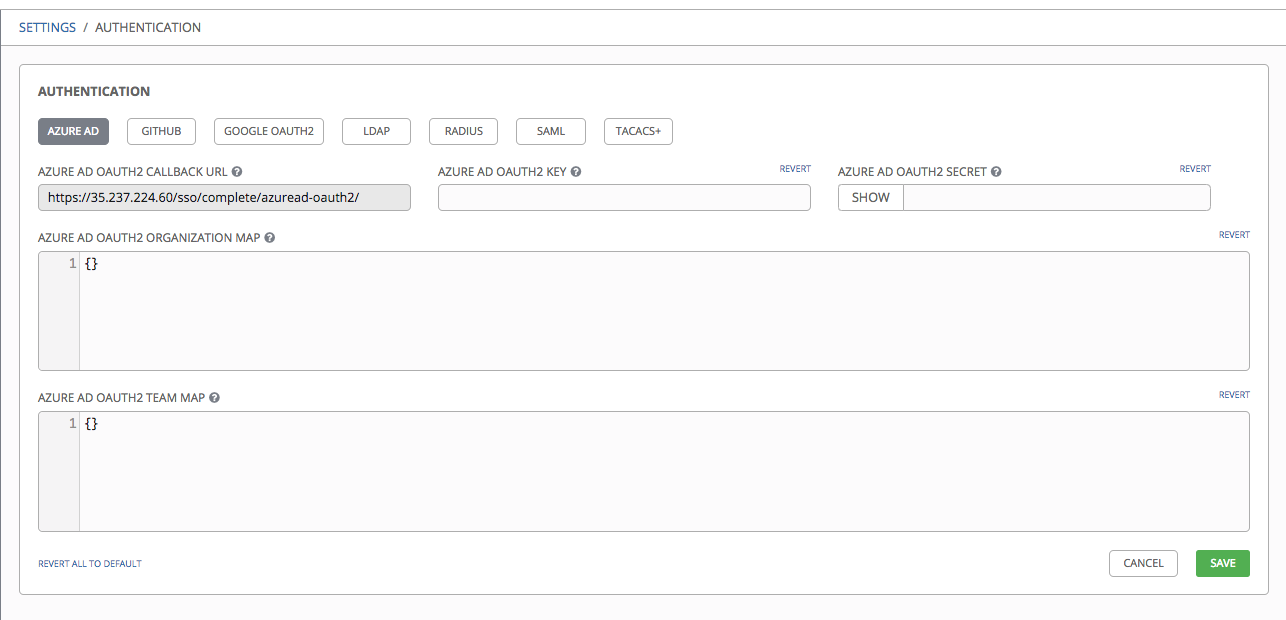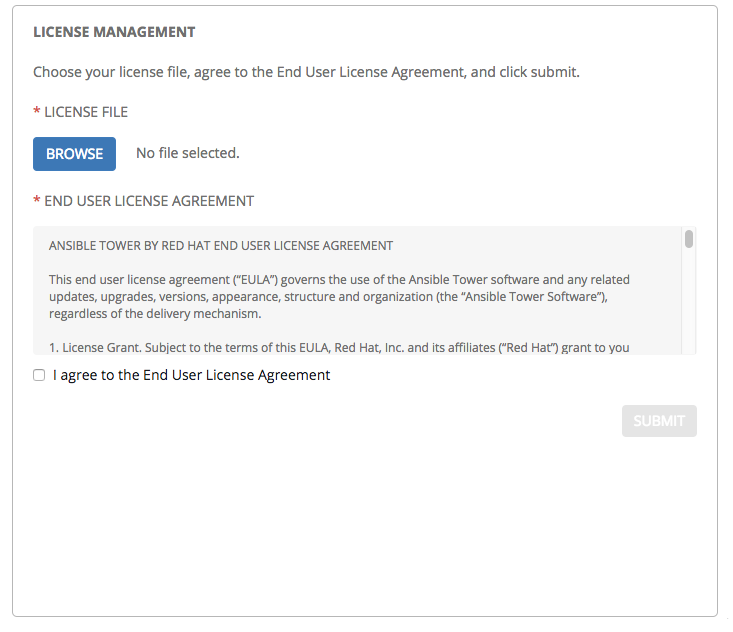13. Tower Configuration¶
You can configure various Tower settings within the Settings screen in the following tabs:

Each tab contains fields with a Reset button, allowing you to revert any value entered back to the default value. Reset All allows you to revert all the values in the Edit Tower Configuration to their factory default values.
Save applies changes you make, but it does not exit the edit dialog. To return to the Configure Tower screen, click the Settings (![]() ) icon from the left navigation bar or use the breadcrumbs at the top of the current view.
) icon from the left navigation bar or use the breadcrumbs at the top of the current view.
13.1. Authentication¶
Through the Tower user interface, you can set up a simplified login through various authentication types: GitHub, Google, LDAP, RADIUS, and SAML. After you create and register your developer application with the appropriate service, you can set up authorizations for them. Since configuration files are now saved to the postgres DB in Ansible Tower 3.1 instead of flat files, setting up authorizations in the Ansible Tower User Interface is the recommended method.
From the left navigation bar, hover over the Settings (
 ) icon and select Authentication or click the Authentication tab from the Settings screen.
) icon and select Authentication or click the Authentication tab from the Settings screen.The Authentication window opens. Select the appropriate authentication type from the row of tabs across the top of the window.

Different authentication types require you to enter different information. Be sure to include all the information as required.
Note
For more detail about each authentication type, refer to the Setting Up Authentication section of the Administration Guide.
Click Save to apply the settings or Cancel to abandon the changes.
13.2. Jobs¶
The Jobs tab allows you to configure the types of modules that are allowed to be used by Tower’s Ad Hoc Commands feature, set limits on the number of jobs that can be scheduled, define their output size, and other details pertaining to working with Jobs in Tower.
From the left navigation bar, hover over the Settings (
 ) icon and select Jobs or click the Jobs tab from the Settings screen.
) icon and select Jobs or click the Jobs tab from the Settings screen.Set the configurable options from the fields provided. Click the tooltip
 icon next to the field that you need additional information or details about.
icon next to the field that you need additional information or details about.
Note
The value for Default Job Timeout is in seconds.

Click Save to apply the settings or Cancel to abandon the changes.
13.3. System¶
The System tab allows you to define the base URL for the Tower host, configure alerts, enable activity capturing, control visibility of users, enable certain Tower features and functionality through a license file, and configure logging aggregation options.
From the left navigation bar, hover over the Settings (
 ) icon and select System or click the System tab from the Settings screen.
) icon and select System or click the System tab from the Settings screen.The System window opens. Select an option from the row of tabs across the top of the window:
Misc. System: define the base URL for the Tower host, enable tower administration alerts, and allow all users to be visible to organization administrators.
Activity Stream: enable or disable activity stream.
Logging: configure logging options based on the type you choose:

For more information about each of the logging aggregation types, refer to the Tower Logging and Aggregation section of the Ansible Tower Administration Guide.
Set the configurable options from the fields provided. Click the tooltip
 icon next to the field that you need additional information or details about.
icon next to the field that you need additional information or details about.

Note
The Allow External Users to Create Oauth2 Tokens setting is disabled by default. This ensures external users cannot create their own tokens. If you enable then disable it, any tokens created by external users in the meantime will still exist, and are not automatically revoked.
Click Save to apply the settings or Cancel to abandon the changes.
13.4. User Interface¶
The User Interface tab allows you to set Tower analytics settings, as well as configure custom logos and login messages.
Access the User Interface settings by hovering over the Settings (![]() ) icon from the left navigation bar and select User Interface or click the User Interface tab from the Settings screen.
) icon from the left navigation bar and select User Interface or click the User Interface tab from the Settings screen.

13.4.1. Usability Analytics and Data Collection¶
In Ansible Tower version 2.4.0, a behind the scenes functionality was added to Tower to collect usability data. This software was introduced to better understand how Tower users specifically interact with Tower, to help enhance future releases, and to continue streamlining your user experience.
Only users installing a trial of Tower or a fresh installation of Tower are opted-in for this data collection.
If you want to change how you participate in this analytics collection, you can opt out or change your settings using the Configure Tower user interface.
Ansible Tower collects user data automatically to help improve the Tower product. You can control the way Tower collects data by setting your participation level in the User Interface tab.
Select the desired level of data collection from the Analytics Tracking State drop-down list:
Off: Prevents any data collection.
Anonymous: Enables data collection without your specific user data.
Detailed: Enables data collection including your specific user data.
Click Save to apply the settings or Cancel to abandon the changes.
Note
This setting was previously configured via PENDO, which is no longer supported.
13.4.2. Custom Logos and Images¶
You can also add a custom logo by uploading an image; and supply a custom login message from the User Interface screen in Configure Tower.

Refer to the tooltips ( ) for acceptable formats.
) for acceptable formats.

13.5. License¶
Tower requires a valid license to run. If you did not receive a license from Ansible directly or via email, or have issues with the license you received, refer to http://www.ansible.com/license for free and paid license options (including free trial licenses) or contact Ansible via the Red Hat Customer portal at https://access.redhat.com/.
Note
To successfully add your license, you must be logged on as the Superuser. Otherwise, the operation will fail.

To add your license:
Save your license (or save the license contents to a text file locally, if needed).
Click the Settings (
 ) icon from the left navigation bar and select the License tab from the Settings screen.
) icon from the left navigation bar and select the License tab from the Settings screen.Click the Browse button and navigate to the location where the license file is saved to upload it. The uploaded license may be a plain text file or a JSON file, and must include properly formatted JSON code.
Once uploaded, check to agree to the End User License Agreement and click Submit.
Once your license has been accepted, Tower navigates you to the main Ansible interface for the Dashboard (which you can access by clicking on the Ansible Tower logo at the top left of the screen as well).
For later reference, you can view this license from the License tab of the Settings screen, accessible through the Settings (![]() ) icon from the left navigation bar.
) icon from the left navigation bar.

